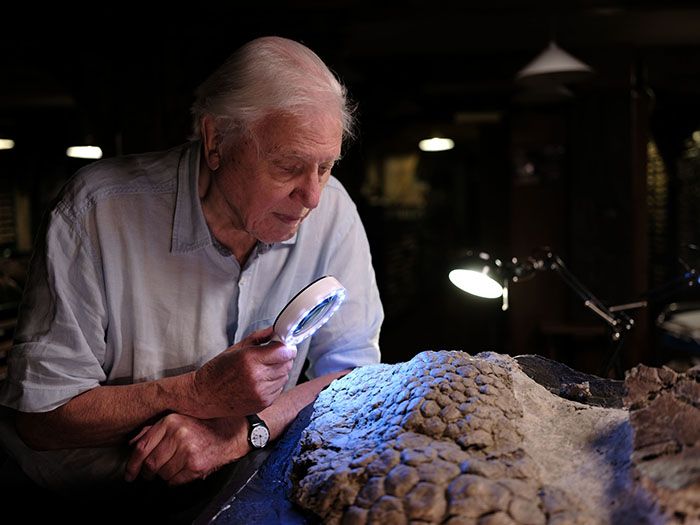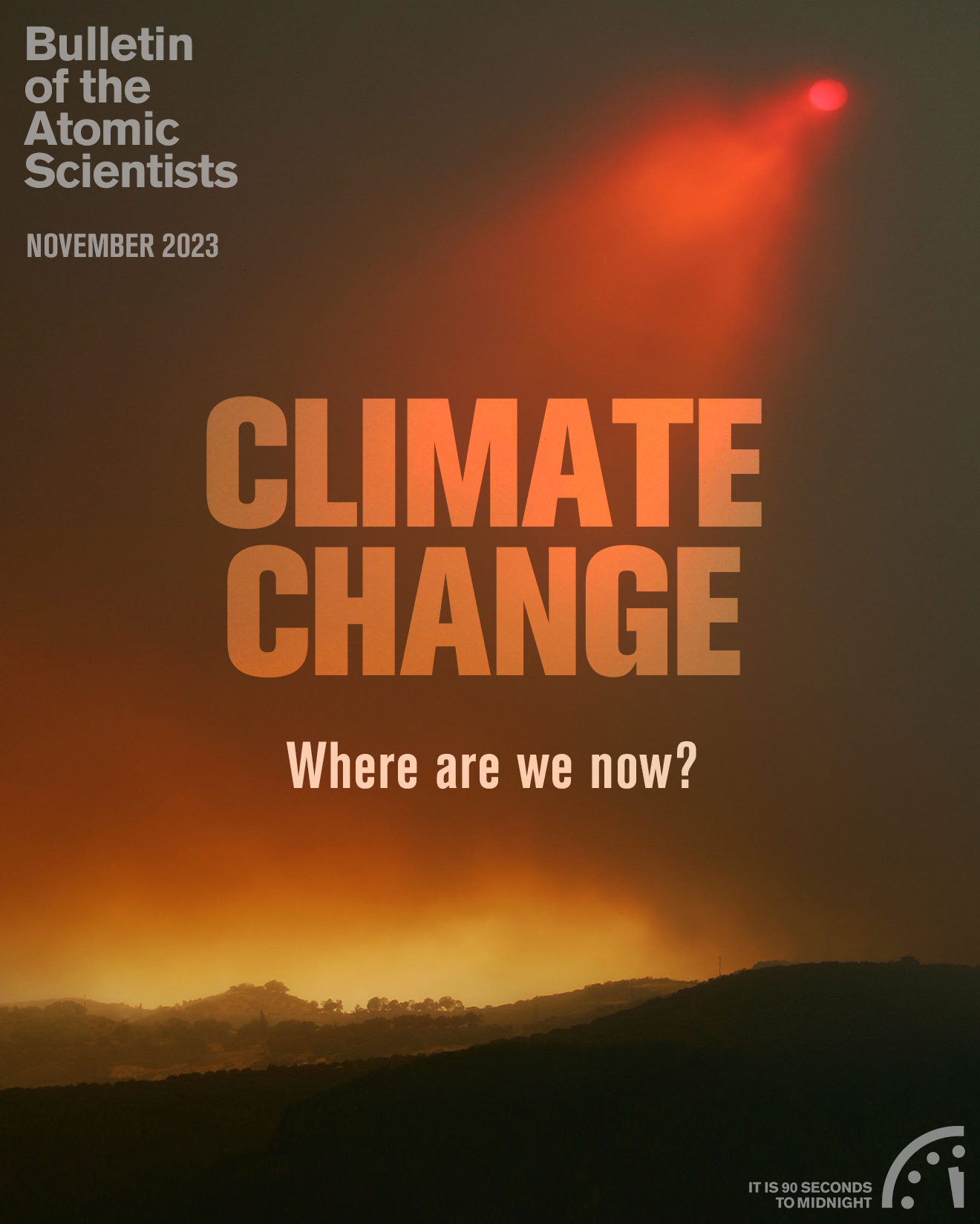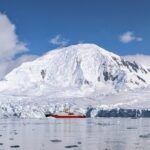Book excerpt—Catastrophic climate change: Lessons from the dinosaurs
By Michael E. Mann | November 8, 2023
Book excerpt—Catastrophic climate change: Lessons from the dinosaurs
By Michael E. Mann | November 8, 2023
Editor’s note: The following essay is an extract from climate scientist Michael Mann’s new book, Our Fragile Moment: How Lessons from Earth’s Past Can Help Us Survive the Climate Crisis, published in September 2023 by Public Affairs/Hachette Book Group. Used with permission.
Hey, mighty brontosaurus.
Don’t you have a lesson for us?
You thought your rule would always last.
There were no lessons in your past.
You were built three stories high.
They say you would not hurt a fly.
If we explode the atom bomb,
Would they say that we were dumb?
—GORDON SUMNER (AKA STING),
“Walking in Your Footsteps”
Do the dinosaurs, victims of a famous 66-million-year-old mass extinction event, have a message for us? That rhetorical question was posed by the rock band The Police in their 1983 song “Walking in Your Footsteps,” which came out during my junior year in high school. What I and most listeners weren’t aware of then was that this evocative track off the album Synchronicity was actually a parable about the Cold War, nuclear holocaust, and—though The Police themselves may not have intended it as such—catastrophic climate change.
As we will see, there are remarkable parallels indeed between the dinosaur-killing asteroid impact and Nuclear Winter worries. There is a direct scientific connection via a shared scenario of global climate change (cooling, rather than warming, in this case). But there are lessons here about the nature of scientific understanding and how it evolves, the self-correcting nature of science, the tactics used by vested interests to undermine public faith in science disadvantageous to their business model, and how all of this impacts the public discourse over planetary environmental threats—be they the prospect of Nuclear Winter we faced in the 1980s or the climate crisis we face today.
In fall 1984, just a year after “Walking in Your Footsteps” was released, I arrived at the University of California at Berkeley to pursue an undergraduate degree in physics. I had been lured there, in part, by the prospect of learning from the school’s scientific luminaries, which included a dozen Nobel laureates. A few years earlier, in 1980, one of their Nobel Prize–winning physicists, Luis Alvarez, and his geologist son Walter had made an Earth-shattering discovery. Literally. They had analyzed layers of deep-sea sediment around the world that all dated to the transition between the Cretaceous period and the Paleogene period, known as the K-Pg boundary (it was once referred to as the K-T boundary). The K-Pg deposits showed evidence of a massive impact event, containing levels of iridium—a hard, brittle, silvery-white metal that is extremely rare in Earth’s crust, but common in extraplanetary asteroids.

The K-Pg boundary was no run-of-the-mill geological boundary. It coincided with the mass extinction event that ended the dinosaurs’ own fragile moment. Having been ushered in by an earlier mass extinction 250 million years ago known as the Permian-Triassic (PT) event, dinosaurs were in turn exterminated by the K-Pg extinction event. Live by the mass extinction, die by the mass extinction. There are always winners and losers. And the winners can’t win ’em all. This time the dinosaurs were the losers, and the beneficiaries were us, the mammals.
Sediments below the K-Pg layer contain fossils of iconic therapods like Tyrannosaurus rex. Sediments above that layer? Not only are dinosaur fossils completely absent, but there are no fossil remains of any large terrestrial species (specifically those estimated to have weighed more than about 50 pounds). Unlike smaller reptiles and early mammals, large creatures were unable to shield themselves from the ensuing environmental Armageddon by hiding in burrows. Roughly three-quarters of all animal species perished. Some mass extinctions—such as the P-T event—are complicated, with several factors or combinations of factors possibly at play. This one is simple. An asteroid killed off the dinosaurs and every amphibian, reptile, and mammal larger than a bulldog. (The one exception is the semiterrestrial crocodile.) Understanding the precise details of what unfolded, and how that relates to our current moment, will nonetheless require a bit more digging.
If this were a murder case, the critical piece of evidence missing at the time of the bombshell Alvarez discovery in 1980 was the weapon. It had been found in the 1970s, when geophysicists searching the Yucatán Peninsula for oil (it always seems to come back to fossil fuels) had uncovered evidence of a massive, roughly 100-mile-wide crater, known as Chicxulub.
At the time, these geophysicists didn’t recognize the crater as the aftermath of the impact by a bolide—a large meteor that explodes in the atmosphere, which in this case was an asteroid, or a small rocky body orbiting the sun. It wasn’t an oversight—craters can come from other sources, like volcanic eruptions. Only in 1990, a full decade after the Alvarez discovery, did other scientists nail that down. Geoscientist Alan Hildebrand and colleagues uncovered geological and geochemical evidence from Chicxulub—including exotic minerals, such as shocked quartz (a type of quartz that is only formed under extremely high pressure), and geological formations suggestive of a huge shock wave—that the crater was indeed formed by a very large, roughly six-mile-wide asteroid. And the sediments dated to the K-Pg boundary. Weapon found. We have a conviction.
It is hard to imagine what this event might have looked and felt like, for there are simply no modern analogs for such a cataclysmic event. The asteroid struck Earth with the almost inconceivable force of somewhere between 100-million and 10-billion Hiroshima bombs. Evidence of the aftermath has been collected by scientists over several decades, and it does provide some remarkable glimpses of what unfolded. Scientists, for example, have detected geological structures formed by seismic waves that emanated outward from the impact. The concentric ripples traveled through soil and rock as if it were warm maple syrup. Massive amounts of dust, soot, and particulate matter known as aerosols were blasted into the atmosphere. Seismic imaging reveals evidence of mile-high tsunamis that assaulted the Gulf Coast of North America. Supercomputers have recently been used to simulate the physics of the collision, suggesting that the asteroid probably struck at an angle of about 60 degrees, rather than a right angle. That would have maximized the ejection of debris into the atmosphere, a worst-case scenario for the dinosaurs.[1]

Our best window into the event yet, however, was provided recently, in the form of the remains uncovered by a team of paleontologists at the Tanis site in North Dakota, about 2,000 miles away from the asteroid impact. We typically talk about what fossil remains can be found before the event or after the event. But in this very rare case, the fossils—which were exquisitely preserved in layers of mud and tree resin—appear to have actually been directly tied to the event itself. The jumbled remains of animals and plants, both terrestrial and aquatic, seem to have been caught up in wave-like torrents of water excited by the seismic tremors created by the impact event. The leg of a Thescelosaurus (meaning “wonderous lizard”)—a small, roughly 10-foot-long, herbivorous, bipedal dinosaur with a sturdy build, small forearms, long pointed snout, and large bony eyebrows—was found, still covered with skin. The skin of a horned triceratops was recovered, scales intact. There’s an embryo of a flying pterosaur, still inside its egg. A turtle fossil was found, impaled by a wooden stake. So, too, were some of our small mammal ancestors, along with burrows they had dug. Most remarkable of all, there appears to be a fragment from the asteroid itself. This is, of course, just one site where scientists were fortunate enough to uncover what happened at the moment of the K-Pg event. Imagine scenes like this occurring at the same precise moment across North America, South America, Eurasia, Africa, and Australia. Now we have some sense of what this event might have been like.
The 1980 discovery that an asteroid had killed the dinosaurs was remarkably timed. It was the Reagan era, the height of tensions between the Americans and the Soviets. There was an escalating nuclear arms race between the two nations, and mankind was threatened with the prospect of a devastating global thermonuclear war.
As suggested by the lyrics that began this chapter, there was an eerie connection between these two events: the asteroid that doomed the dinosaurs and the existential threat posed by nuclear war. One might call it synchronicity—the Jungian concept that two events disconnected in space and time can be meaningfully related while lacking any direct causal connection. (Hence the use of the word for that Police album.)
The massive dust and debris ejected into the atmosphere by the K-Pg asteroid impact blanketed the planet. Massive terrestrial wildfires were ignited by the burning debris that was ejected, generating substantial amounts of smoke and soot. The dust, debris, and soot remained suspended in the atmosphere for years, reflecting a sizeable portion of incoming sunlight back to space, and sending the planet into a sort-of perpetual winter while also severely limiting photosynthesis—a double whammy for life on Earth. Larger land animals who could not burrow into the Earth, to limit their exposure to either any initial fires or, more importantly, the subsequent chill, selectively perished. The dinosaurs were among the casualties.
So, ironically, it wasn’t global warming but global cooling that delivered their fate. Herein lies a key observation: what creates vulnerability to climate change isn’t so much the precise nature of that change (for example, cooling versus warming), but what conditions species are accustomed to. Plants and animals can adapt to slow changes. Very rapid changes, not so much. Today, the rate at which climate zones are shifting poleward with warming is exceeding the rate at which many plants and animals can move, threatening (along with deforestation, habitat destruction, pollution, ocean acidification, and other activities) a human-caused sixth extinction event. If climate zones were shifting equatorward instead, due to equally rapid global cooling, animal and plant species would be similarly threatened. It’s not just the magnitude of change but the rate of change that matters here.[2]
What is the relevance of all of this to global thermonuclear war? Obviously, a massive bolide strike and a massive array of nuclear detonations would both cause great physical destruction—they clearly have at least that much in common. Popular depictions of thermonuclear holocaust in the early 1980s portrayed the widespread physical devastation that would be rendered—entire cities destroyed, large populations of human beings in urban centers vaporized.
In summer 1983, just after the completion of my junior year in high school, my friends and I went to see the film WarGames in a crowded, hot movie theater in Hyannis, Massachusetts, during a week-long bike trip to Cape Cod. The protagonist, played by a young Matthew Broderick, is a nerdy yet brash teenage science prodigy who accidentally gets into the NORAD computer, code-named “Joshua,” that controls the US nuclear arsenal. He ends up triggering a nuclear escalation that appears to be headed toward mutually assured destruction. The computer assesses the impact of prospective strikes against Soviet population centers and the likely Soviet counterstrikes. Broderick’s character saves the day by getting Joshua to play tic-tac-toe against itself and “learn” that there can be no winner, in either tic-tac-toe or a full-scale thermonuclear war. Joshua memorably exclaims, to the relief of those gathered, that “the only winning move is not to play.”[3]
Just before the Thanksgiving holiday that year, The Day After (not to be confused with the much later, 2004 climate change–themed film The Day After Tomorrow) aired as a special on the ABC network. With 100-million viewers, it was the most-watched TV film of all time. The film depicted a full-scale nuclear exchange between the United States and the Soviet Union, focusing on the residents of Lawrence, Kansas, and the collapse of civilizational infrastructure that occurs both in the lead-up to war and then in its aftermath. I remember my high school offering special counseling sessions for distraught students the day after the film. (This was in the progressive college town of Amherst, Massachusetts; my wife, who grew up in the more conservative community of Darien, Connecticut, remembers nothing of the sort.)

Both WarGames and The Day After focused on the acute physical devastation and mortality that would be caused by an all-out nuclear war—adequate grounds on its own to end the Cold War escalation. Ronald Reagan himself wrote in his diary that he was inspired by The Day After to engage in more concerted efforts to achieve an arms agreement with Russia. But the impacts were for the most part depicted as fleeting. The implication was that if one managed to avoid the direct strikes and exposure to radiation, one could survive a nuclear holocaust. Both films were in production by 1982. But by the time they appeared, in mid- to late-1983, a yet more dire picture had emerged.
That’s when Carl Sagan comes into the picture. If you’re looking for more “meaningful coincidences,” the name Carl—be it Carl Jung or Carl Sagan—is, according to numerologists, associated with “intellectuals, deep thinkers, philosophers and scholars,” whose “souls are visionary and their way of thinking unique.”[4]
Sagan and his collaborators had been researching the potential climate impacts of a global thermonuclear war. They found that the massive dust, wildfire smoke, and aerosols that would be ejected into the atmosphere by a series of thermonuclear detonations in the United States and Eurasia could trigger a nuclear winter. In December 1983, they published their findings in the leading journal Science. The publication has come to be known as TTAPS, named after the authors (Turco, Toon, Ackerman, Pollack, and Sagan) of the article. The team estimated that several thousand megatons of nuclear detonations would lead, within a matter of weeks, to an 80 percent reduction in sunlight reaching the surface of the Earth. They calculated that this would cause a cooling of 27–45 degrees Fahrenheit over mid-latitude land regions, yielding subfreezing temperatures for months, even in summer. The combination of extreme cold, nuclear fallout, radiation exposure, and ozone destruction, they argued, could “pose a serious threat to human survivors and to other species.” In other words, even those who survived the immediate physical devastation of a global thermonuclear war might suffer the same fate as the dinosaurs, perishing from the sustained deep freeze.[5]
Scientists had speculated about nuclear winter as early as the late 1970s. Paul Ehrlich; his wife, Anne Ehrlich; and their colleague John Holdren (who went on to become President Barack Obama’s science adviser in 2009) discussed the possibility that the dust and smoke from a nuclear war could have a cooling effect similar to an explosive volcanic eruption, like the 1815 Mount Tambora eruption, back in 1977. In 1982, a year before the publication of TTAPS, Paul Crutzen—who would go on to share the 1995 Nobel Prize in Chemistry with Sherry Rowland and Mario Molina for working out the chemistry behind human-caused ozone depletion back in the early 1970s—coauthored an article (“The Atmosphere After a Nuclear War: Twilight at Noon”) estimating that the smoke and aerosols from nuclear war–induced fires could reduce sunlight by as much as a factor of a hundred, dramatically decreasing photosynthesis with adverse consequences for agriculture. They concluded that nitrates produced by the massive fires would worsen both ozone depletion and acid rain. They drew a direct analogy with the K-Pg mass extinction event.
Sagan and his TTAPS colleagues, however, were the first to quantitatively estimate the cooling impact of nuclear winter. Sagan perceived it such an imminent and existential threat to humanity that he chose to do something somewhat unusual (and often frowned upon) for a scientist: going public with his findings before the work was peer-reviewed and published. Launching his efforts in October 1983, several months before publication, Sagan set out to warn the public of the dire threat posed by the escalating arms race and nuclear winter. The publicity campaign included a high-profile press conference. It also included an October 30 commentary that served as the cover story of the widely read Parade Sunday newspaper insert, which had a circulation in excess of 30 million. The front cover featured an image of a devastated Earth half covered in shadow and sprinkled with icy white snow, posing the rhetorical question: “Would nuclear war be the end of the world?”
Sagan’s actions rubbed some of his fellow scientists the wrong way. They were critical of some of the assumptions made in the TTAPS article and felt that the findings should have been litigated through the normal scientific process, rather than aired in public prior to publication. What started out as an internal scientific disagreement would soon spill out into the public arena. It would also play into the hands of Cold War hawks looking to discredit Sagan’s call for nuclear de-escalation—and, ultimately, it would fan the flames of climate change denialism, as we’ll learn later.
As we have seen, Sagan was assisted in his publicity efforts—if somewhat serendipitously—by The Police with “Walking in Your Footsteps,” released in mid-1983, just months before Sagan’s nuclear winter publicity campaign. The song was written by Sting one December 1982 morning on the Caribbean island of Montserrat. That makes the work eerily prescient because it preceded any widespread public awareness of the nuclear winter threat. Though the song was written about nuclear war, the analogy drawn between the effects of a global nuclear conflict and the demise of the dinosaurs is far more fitting than Sting presumably realized when he wrote the song..[6]
Endnotes
[1] Nicholas St. Fleur, “Drilling into the Chicxulub Crater, Ground Zero of the Dinosaur Extinction,” New York Times, November 17, 2016, https://www.nytimes.com/2016/11/18/science/chicxulub-crater-dinosaur-extinction.html; Daphne Leprince-Ringuet, “Supercomputer Simulates the Impact of the Asteroid that Wiped out Dinosaurs,” ZDNET, May 26, 2020, https://www.zdnet.com/article/supercomputer-simulates-the-impact-of-the-asteroid-that-wiped-out-dinosaurs/; David Kindy, “Mile-High Tsunami Caused by Dinosaur-Killing Asteroid Left Behind Towering ‘Megaripples,’” Smithsonian Magazine, July 19, 2021, https://www.smithsonianmag.com/smart-news/mile-high-tsunami-caused-dinosaur-killing-asteroid-left-behind-towering-megaripples-180978229/
[2] See, for example: Elizabeth Kolbert, The Sixth Extinction: An Unnatural History (London: Bloomsbury, 2014).
[3] The film, as I recount in The Hockey Stick and the Climate Wars (New York: Columbia University Press, 2012), so impacted me that I ended up coding a self-learning tic-tac-toe program in school next fall.
[4] See: “Carl,” BabyCentre, accessed May 1, 2022, https://www.babycentre.co.uk/babyname/1005569/carl; Polly Logan-Banks, “Number 7 Numerology,” BabyCentre, accessed May 1, 2022, https://www.babycentre.co.uk/a25017039/number-7-in-numerology. I feel compelled to point out that, as apt as this description might seem of Carl Sagan, he would be among the first to dismiss such superstitious assessments. And as a person of science, I would have to side with him. But I also feel compelled to note that Carl Jung might have embraced this ostensible additional example of synchronicity.
[5] For a comprehensive review of the so-called TTAPS article, see: Naomi Oreskes and Erik M. Conway, Merchants of Doubt: How a Handful of Scientists Obscured the Truth on Issues from Tobacco Smoke to Global Warming (New York: Bloomsbury, 2010).
[6] “Walking in Your Footsteps,” The Police Wiki, accessed September 17, 2021, http://www.thepolicewiki.org/Police_wiki/index.php?title=Walking_In_Your _Footsteps . It is fair to quibble a bit with the lyrics, incidentally. We might take note, for example, that Brontosaurus was not a casualty of the K-Pg impact event. It actually went extinct 79 million years earlier, in the late Jurassic period. Lest that seem like a minor dating error, let us note that more time elapsed between the demise of Brontosaurus and the occurrence of the K-Pg extinction event than has elapsed since the K-Pg event. While we’re quibbling about dating, the K-Pg event was 66 million years ago, not the “fifty million years” mentioned in the lyrics. Brontosaurus, finally, wasn’t actually even a “thing” by 1982. In the 1970s, it was discovered to, in reality, be the same species as the earlier-named species Apatosaurus. When naming dinosaurs, it’s first come, first served. Paleontologists, following the rule book, had to cancel poor Brontosaurus. But an engaging song and an apt metaphor are deserving of some degree of leniency and poetic license, and we should forgive these minor transgressions.
Together, we make the world safer.
The Bulletin elevates expert voices above the noise. But as an independent nonprofit organization, our operations depend on the support of readers like you. Help us continue to deliver quality journalism that holds leaders accountable. Your support of our work at any level is important. In return, we promise our coverage will be understandable, influential, vigilant, solution-oriented, and fair-minded. Together we can make a difference.
Keywords: climate change, climate crisis, extinction, global warming, nuclear winter, wildfire
Topics: Climate Change





















